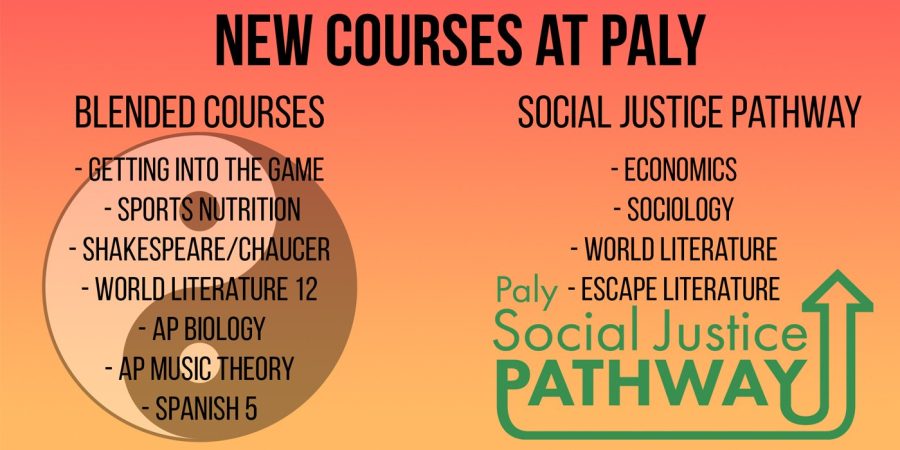Twelve new courses have been added to Palo Alto High School’s course offering, among them blended and twilight classes.
Blended classes began in 2009 at Henry M. Gunn High School and soon spread to Paly. Some of the classes have flex time in which students have free class periods during the week to use for what they need, whether it be meeting with teachers or studying on their own. During these flex periods, students do not have to attend class. Twilight classes will be offered one day per week during after school hours.
“Blended courses give students more flexibility and choice in their daily schedules, as well as encourage more independent, student-driven learning and provide more opportunities for one-on-one time between teacher and student,” Advanced Placement Psychology teacher Melinda Mattes said.
The new blended classes for the 2016-17 school year are Getting into the Game, Interior Design 11/12, Sports Nutrition, Shakespeare/Chaucer, World Literature 12, AP Psychology, Positive Psychology, Algebra 2, AP Biology, AP Music Theory and Spanish 5.
The Social Justice Pathway (SJP) is also introducing new classes for the upcoming year. It will be incorporating Economics, Sociology, World Literature and Escape Literature into SJP curriculum.
Many students utilize their time talking with their teachers or catching up on reading and homework. However, there are also drawbacks to this extra free period.
“The blended classes gives more choice in how they manage their time, and the flexibility of a blended class give kids a chance to seek help when they need it,” Social Science teacher Eric Bloom said. “The blended classes also give kids the option to waste time and so a down side of less structure is that some kids are allowed to make bad choices.”
However, blended classes are not built to fit every class dynamic or structure. The blended curriculum allows teachers to incorporate more unique and creative approaches to education that classes with standardized curricula would not have room or time for.
“Educational research suggests that giving kids more choice in how to demonstrate competency raises achievement, and offering classes that are not pegged to a national test [such as APs] allows teachers to be more creative in how they ask students to demonstrate competency; more engaged students learn more,” Bloom said.
These classes are newly introduced as per student or teacher interest, so if less than around 28 students indicate interest in signing up for a class, the course will not be offered.
“New classes come from teacher ideas, coupled with student interest, and require teachers who are willing to do the hard work of creating and designing the new courses,” Mattes said.
In order to be a teacher of blended learning courses, teachers must undergo training, and Paly is currently holding its fifth training. Teachers are not required by administration to attend these trainings unless they choose to teach a blended class.
Right now, there are nine teachers at Paly teaching the blended classes, and some are teaching twilight classes as well. In twilight classes, students are given a prep period during the day and meet once a week after school from 5 p.m. to 7:30 p.m. During the time spent outside of class, students complete work and projects online.
“The whole big picture with blended and with twilight and all of the interesting electives is to give students more choices and options,” Spanish 5 teacher Emily Garrison said. “We have a really big school, we are lucky enough to be able to do blended learning and to have it supported. So, it’s all about student options.”
To aid students in course selection this year, Paly’s Input Club has created a supplemental online course catalog resource to digitally aggregate course information. It lists course descriptions for each class among other data, including time spent on homework, grade information and Advanced Placement (AP) data when applicable.



